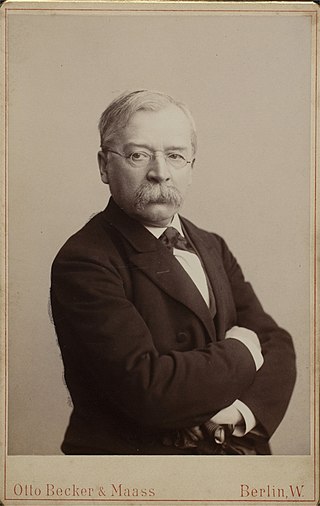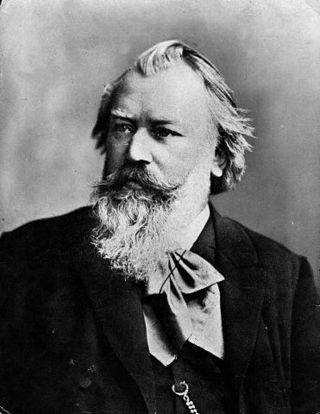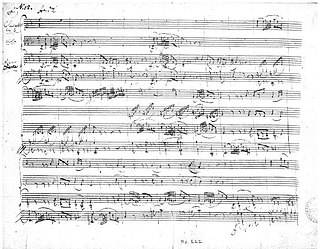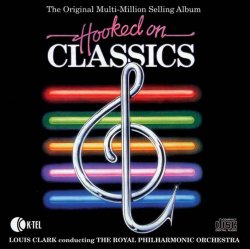Related Research Articles

Robert Fuchs was an Austrian composer and music teacher. As Professor of music theory at the Vienna Conservatory, Fuchs taught many notable composers, while he was himself a highly regarded composer in his lifetime.

Franz Schubert's Impromptus are a series of eight pieces for solo piano composed in 1827. They were published in two sets of four impromptus each: the first two pieces in the first set were published in the composer's lifetime as Op. 90; the second set was published posthumously as Op. 142 in 1839. The third and fourth pieces in the first set were published in 1857. The two sets are now catalogued as D. 899 and D. 935 respectively. They are considered to be among the most important examples of this popular early 19th-century genre.
The Ballades, Op. 10, are lyrical piano pieces written by Johannes Brahms during his youth. They were dated 1854 and were dedicated to his friend Julius Otto Grimm. Their composition coincided with the beginning of the composer's lifelong affection for the pianist and composer Clara Schumann, who was helping Brahms launch his career. Frédéric Chopin had written the last of his famous ballades only 12 years earlier, but Brahms approached the genre differently from Chopin, choosing to take its origin in narrative poetry more literally.
Brahms's Six Pieces for Piano, Op. 118, were completed in 1893 and published with a dedication to Clara Schumann. The set was the penultimate of Brahms's published works. It was also his penultimate work for piano solo.

Woldemar Bargiel was a German composer and conductor of the Romantic period.

The Four Pieces for Piano Op. 119, are four character pieces for piano composed by Johannes Brahms in 1893. The collection is the last composition for solo piano by Brahms. Together with the six pieces from Op. 118, Op. 119 was premiered in London in January 1894.
The Piano Sonata No. 3 in F minor, Op. 5 of Johannes Brahms was written in 1853 and published the following year. The sonata is unusually large, consisting of five movements, as opposed to the traditional three or four. When he wrote this piano sonata, the genre was seen by many to be past its heyday. Brahms, enamored of Beethoven and the classical style, composed Piano Sonata No. 3 with a masterful combination of free Romantic spirit and strict classical architecture. As a further testament to Brahms' affinity for Beethoven, the Piano Sonata is infused with the instantly recognizable motive from Beethoven's Symphony No. 5 during the first, third, and fourth movements. Composed in Düsseldorf, it marks the end of his cycle of three sonatas, and was presented to Robert Schumann in November of that year; it was the last work that Brahms submitted to Schumann for commentary. Brahms was barely 20 years old at its composition. The piece is dedicated to Countess Ida von Hohenthal of Leipzig.

A clarinet–viola–piano trio, often titled "Trio for Clarinet, Viola and Piano" is a work of chamber music that is scored for clarinet, viola, and piano; or is the designation for a musical ensemble of a group of three musicians playing these instruments. This combination of instruments differs from other combinations, as the viola and the clarinet share approximately the same musical range, but not the same tone quality.

The Piano Quartet No. 1 in G minor, Op. 25, was composed by Johannes Brahms between 1856 and 1861. It was premiered in 1861 in Hamburg, with Clara Schumann at the piano. It was also played in Vienna on 16 November 1862, with Brahms himself at the piano supported by members of the Hellmesberger Quartet. Like most piano quartets, it is scored for piano, violin, viola, and cello.

August Winding was a Danish pianist, teacher and composer.
Helen Schnabel, née Fogel, was an American pianist. She was married to the pianist Karl Ulrich Schnabel.
Bernard Zaslav was an American viola soloist and chamber musician with an extensive recording and performance career. A founding member of The Composers Quartet in 1965, he went on to play with the Fine Arts Quartet, Vermeer Quartet, and the Stanford String Quartet. He has also performed and recorded as the Zaslav Duo with his wife, pianist Naomi Zaslav.
Sonatas, duos and fantasies by Franz Schubert include all works for solo piano by Franz Schubert, except separate dances. They also include a number of works for two players: piano four hands, or piano and a string instrument.

Hooked on Classics, produced by Jeff Jarratt and Don Reedman, is a multi-million selling album recorded by Louis Clark and the Royal Philharmonic Orchestra, published in 1981 by K-tel and distributed by RCA Records, part of the Hooked on Classics series.
The Three Intermezzi for piano, Op. 117, are a set of solo piano pieces composed by Johannes Brahms in 1892. They show Brahms' interest in lullaby; in particular, Brahms told a friend that they were "three lullabies of my grief". They consist of:
References
- 1 2 Brahms, Johannes; Eich, Katrin; Boyde, Andreas (2015). Fantasien, piano, op. 116. München: G. Henle Verlag. LCCN 2015563199. OCLC 912923384.
- ↑ Brahms, Johannes. Mandyczewski, Eusebius (ed.). Complete shorter works for solo piano (The Vienna Gesellschaft der Musikfreunde ed.). New York. ISBN 0-486-22651-4. OCLC 288125.